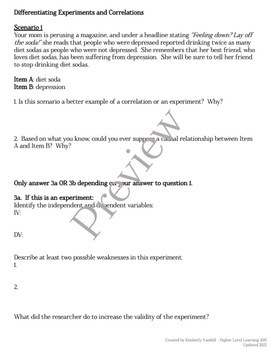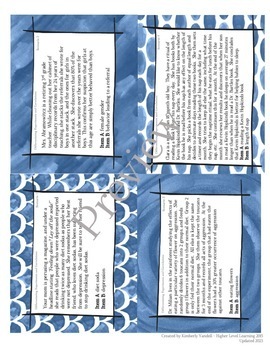Experiments vs. Correlations Project - AP ® Psychology Scientific Foundations
- PDF
Description
Understanding the difference between a correlation and an experiment is a vital part of scoring well on the AP ® Exam, but it is often a difficult concept for students to grasp. This resource by Higher Level Learning has everything you need to make sure your students master this objective in a fun and interactive way! This is a group project designed for an advanced psychology class, but it can be used in any class studying the difference between an experiment and a correlation.
In this project, groups will:
- Be assigned one of ten scenarios.
- Read the scenario and decide whether it is an example of an experiment or of a correlation.
- Analyze the scenario together to answer accompanying high-level questions
- Create a poster and share their learning with the class
This 30 page file includes:
- Detailed lesson plan
- Teacher example to model
- 10 scenarios with questions
- Answer key for closed ended questions (open ended questions left up to teacher discretion to grade)
- Rubric to use when grading the presentations and posters.
- Bonus! Scenario task cards for an abbreviated version of this activity
I gave my students a 90 minute period to answer the questions and create the poster, and then we used another 90 minute period to complete the posters and present to the class.
The objectives covered include:
- Define the qualities of an experiment and a correlation.
- Explain when you can and cannot suppose a causal relationship
- Identify the independent and dependent variables in an experiment
- Analyze an experiment to explain its weaknesses (answers would include not operationally defining variables, lack of repetition, and low sample size among others)
- Assess an experiment and explain how the researcher increased the validity of the results
- Analyze a correlation to determine other possible factors contributing to the relationship
- Determine whether a correlation is positive or negative
- Revise a correlational study into an experiment
- Clearly compose their answers and present them to their classmates in a well thought-out manner.
Check out my AP ® psychology products!
AP ® Psychology Substitute Lesson – Article and Questions on Optimism
Clinical Psychology Graphic Organizers
This is a PDF product that cannot be changed or edited. It is flattened to prevent the lifting of clip art.
Follow me on TPT to stay up to date on my latest products and sales! And be sure to submit a review to receive free products on TPT!
AP ®is a trademark owned by the College Board, which is not affiliated with, and does not endorse, this product. Permission has been given to Higher Level Learning by the College Board to use their trademark according to their guidelines.





